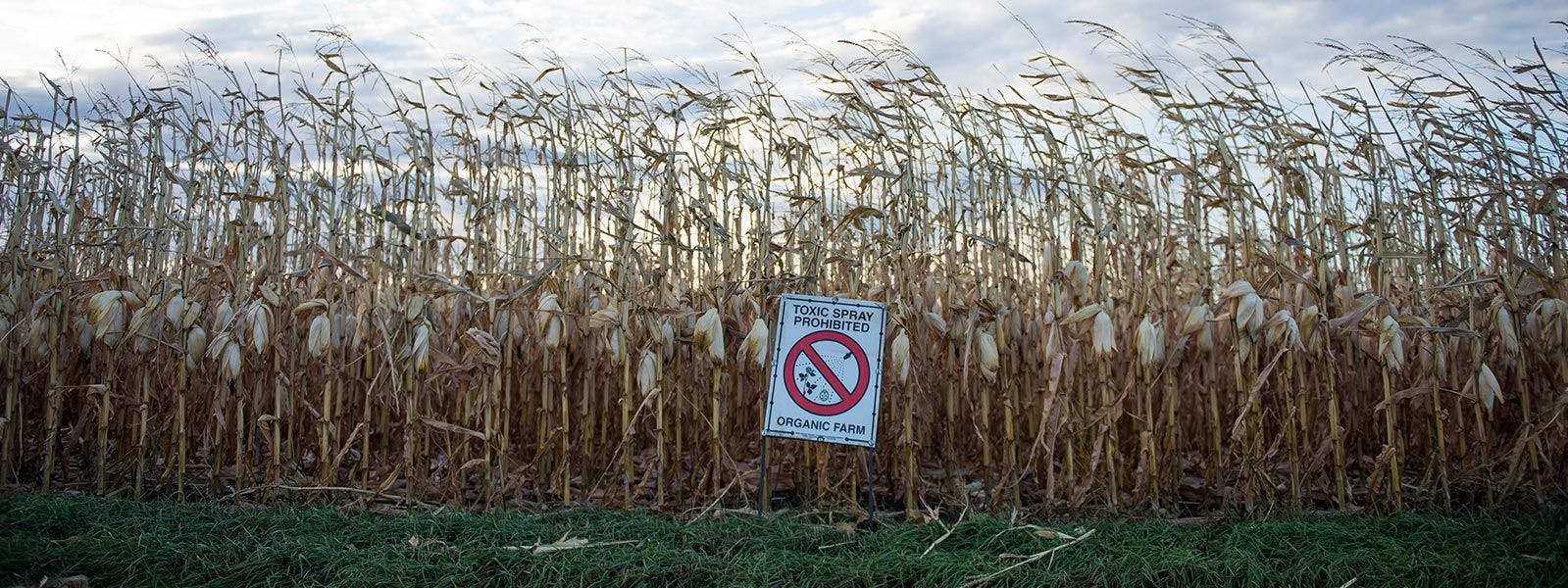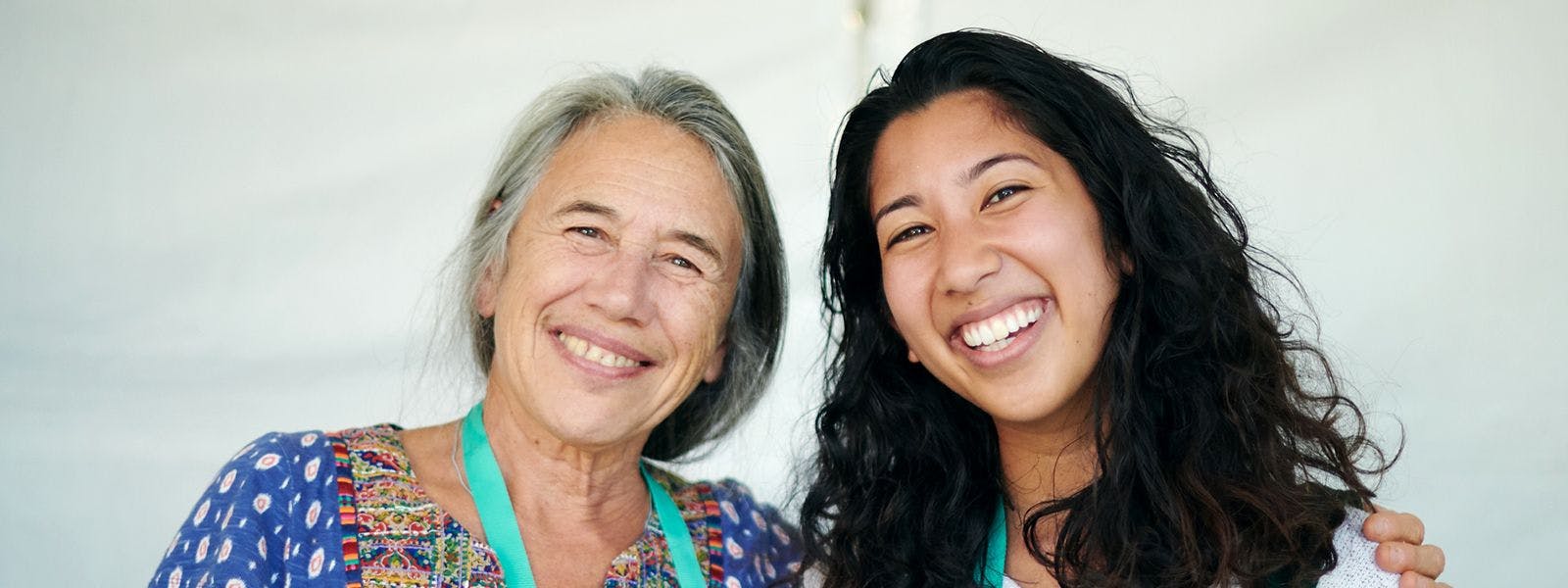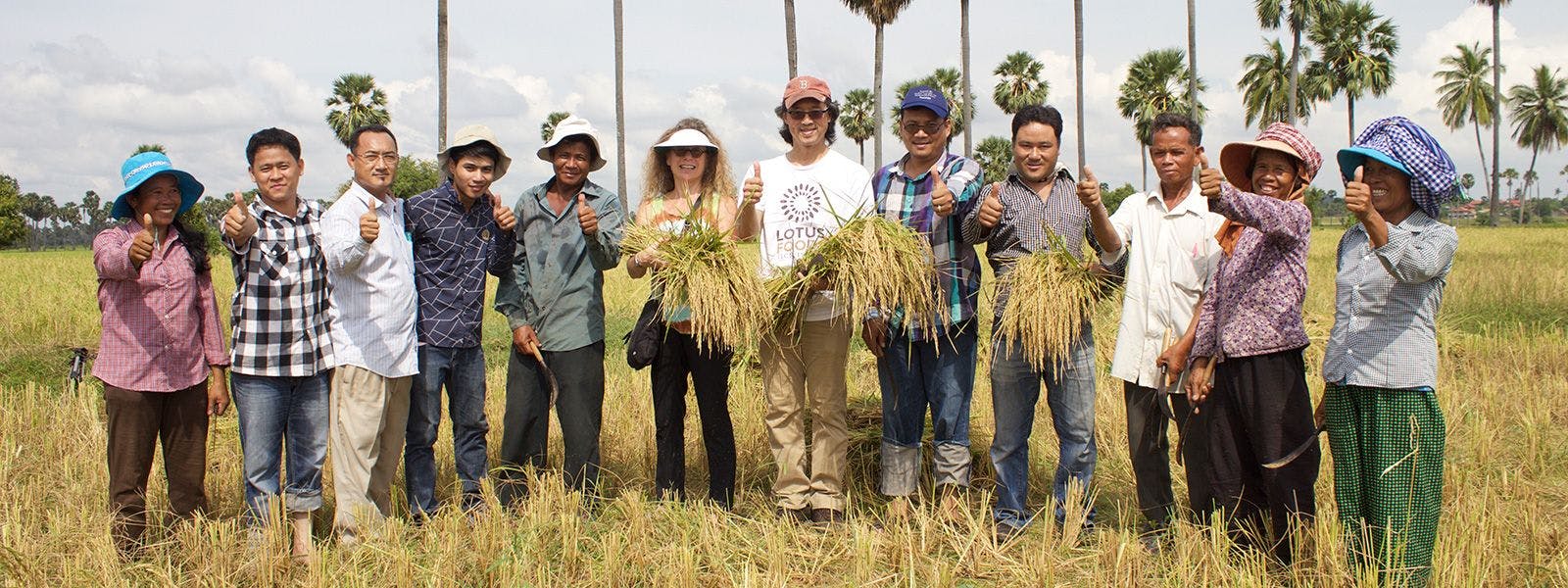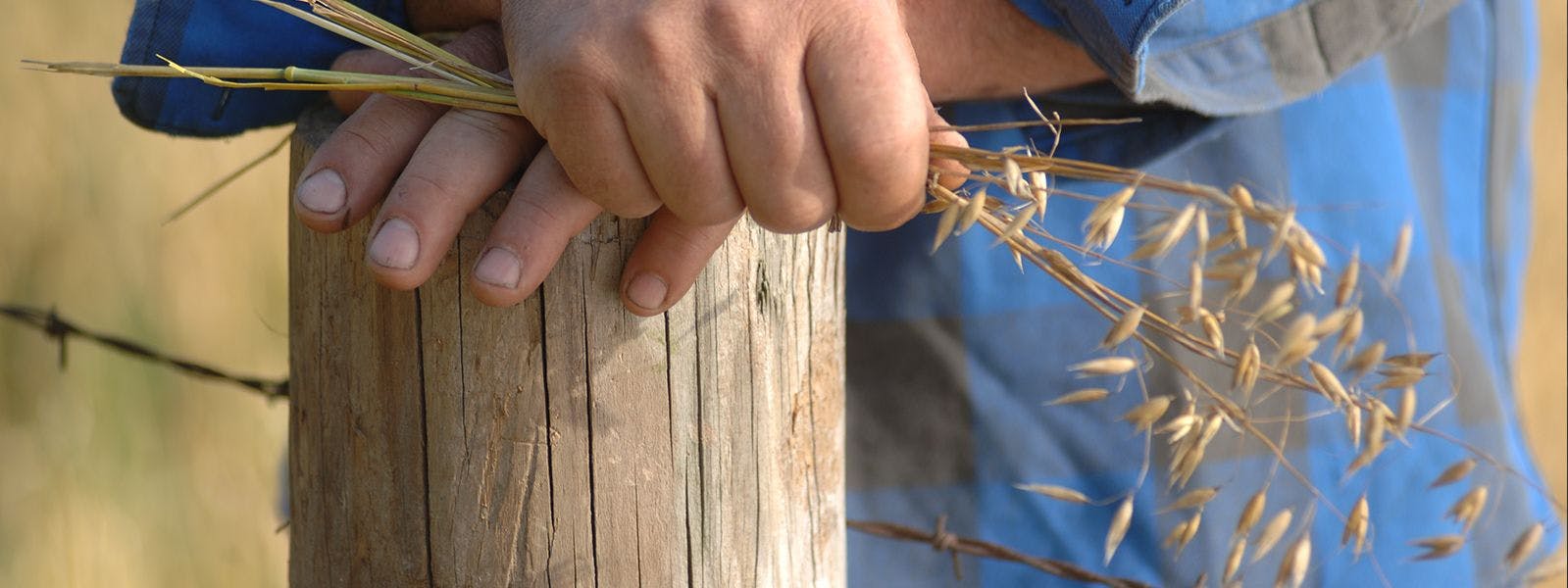
Earth
Liz Carlisle: Lentils, Legumes & the Power of Pulses
Liz Carlisle, a lecturer in the School of Earth, Energy, and Environmental Sciences at Stanford University, shares her personal discovery of sustainable agriculture, the incredible powers of pulses (a special category within the legume family) and so much more. Liz is the author of two books about transitioning to sustainable farming: Lentil Underground, winner of the 2016 Montana Book Award and Grain by Grain, coauthored with farmer Bob Quinn which will be available in 2019.

Tune in to hear about:
- How farmers in Montana turned a cover crop into a cash crop and are fixing nutrients in their soil, all while taking a “slow money” approach.
- Liz’s realizations about conservation, land stewardship, and farming communities on the prairies of Montana.
- How Liz was inspired by Montana politician Senator Jon Tester, who is himself an organic farmer!
- What changed in Montanan agriculture during the farm crisis of the 1980s.
- Lentils, legumes and pulses!
Listen at the link below, on iTunes, Stitcher, Google Play or wherever you get your podcasts.
Rootstock Radio Interview with Liz Carlisle
Air Date: February 25, 2019
Welcome to Rootstock Radio. Join us as host Theresa Marquez talks to leaders from the Good Food movement about food, farming, and our global future. Rootstock Radio—propagating a healthy planet. Now, here’s host Theresa Marquez.
THERESA MARQUEZ: Hello listeners, and welcome to Rootstock Radio. I’m Theresa Marquez, and I’m so delighted today to be welcoming Liz Carlisle from Montana, former country singer turned lecturer of the School of Earth, Energy, and Environmental Science at Stanford University. Today I hope that we’re all going to get really excited about—are you ready for this? —lentils. And also, Liz wrote a book called Lentil Underground, which was a winner of a 2016 Montana Book Award. And I love the byline of it: Renegade Farmers and the Future of Food in America. So, welcome, Liz.
LIZ CARLISLE: Thank you so much—my pleasure.
TM: So, of course, all of us are wondering how someone doing something so sexy as being a country singer decided instead that they were going to be a lecturer and talk about and write a whole book about lentils.
LC: Well, I think it’s all about the really important stories that our farmers and our land stewards have to share with us all. And it’s just been a wonderful journey for me through the music, through working for U.S. Senator Tester—who’s from my home state of Montana and an organic farmer—and then now in my teaching role, to get to hear those stories straight from those land stewards and those farmers, understand what it is the rest of us need to do to help support them in their stewardship, connect them with young sustainability leaders of the future, and just continue to participate in building this really exciting food system movement.
TM: Well, would you mind backing up just a little bit for those of our listeners who don’t know who Senator Tester is. Could you just say a few words about him?
LC: Yeah, absolutely. He’s been one of the great mentors and inspirations in my life and had a huge impact on me in 2006. He was a state legislator who had been a school teacher and a farmer in a little town called Big Sandy, Montana, and just a big believer in rebuilding community economies; had seen what had happened with extractive economies in Montana. We have a history of mining and oil and an extractive agriculture that really hasn’t been good for particularly the rural people in our state.
And he converted to organic in the late ’80s, really saw the impact on his farm and his bottom line, and saw others in his community doing the same thing, and got involved in local politics in the school board and then in the state legislature, and then went for the U.S. Senate. And he was up against a three-term incumbent. Nobody thought this rural guy with a flattop was going to beat this D.C. insider who had all the fundraising connections. And he won—by just a few hundred votes. It was so inspiring.
And he talked about a future based on the green economy for Montana, that we were going to have renewable energy, and we were going to have more organic farms, and this would be really be a broad-based prosperity that would last. And he really inspired me to shift from being a musician to working in his office, because I had heard from farmers across the country about the struggles of the commodity economy and how it just got harder every year. And I really heard that Senator Tester had some solutions and he was really going to work for the people.
And I’m so proud of him: he just got reelected to his third term. He’s been an amazing force in Congress for, I think, really, the interests of everyday people. And a very different story about rural America than we often hear in the media, about really positive solutions and unity and people caring for each other and caring for the land. So, I was just so fortunate to have that formative experience working in his office. And that’s how I ended up meeting the farmers who I did research with and ultimately wrote about in Lentil Underground.
TM: Well, what got me, Liz, when I read about you and read your book is that you’re from Montana, you’re from Missoula. And yet when you started working for Senator Tester, isn’t that where you started opening up your eyes to some things that you just didn’t know about Montana farming?
LC: Yeah, I mean working for Senator Tester completely changed the way I thought about the environment and environmental stewardship. I’m originally from Missoula, Montana. So, if you’ve never been there, it’s right between Glacier Park and Yellowstone Park, just this really beautiful part of the Rocky Mountains where a lot of people come for recreation. I knew a lot of environmentalists who were involved in wilderness conservation, and I was very connected to the outdoors, but specifically to the mountains. And I hadn’t spent a lot of time in the eastern part of the state, which is actually…most of the state is prairie, east of the Rocky Mountains, and it’s less populated. People didn’t think of it as a place with a lot of exciting ideas or culture or stewardship values. And working in Senator Tester’s office really changed my mind.
And I saw some of this when I was traveling as a musician, too. But I saw that, actually, some of the most brilliant and committed stewards—environmental stewards in our state—were these farmers on the prairie who had figured out how to steward their farm systems as ecosystems and really cultivate the wild within those ecosystems and both produce healthy food for people and also create habitat, sustain clean water, build their soils, and in the process, work together in these really inspiring ways, developing cooperate ways of working. There was so much cultural wisdom, also, in that part of the state that was connected to the environmental stewardship.
So that’s the real lesson for me as a western Montanan who had been involved in wilderness conservation and that kind of connection to the environment: that really our stewards, people who are involved in ecological farming, are really some of the most important people doing environmental work and are really on the front lines of it.
TM: Well, you really, then, after being with Senator Tester for like a year or so, decided, “I am going to do something different.” And so you put yourself out there and started to get to know some of these farmers. Tell us about your journey and who you got to know and how you got inspired to write this book, Lentil Underground.
LC: Yeah. Well, at the Tester office, I was a Legislative Correspondent for Agriculture and Natural Resources. So, that meant that my whole job was communicating with people in Montana who were working on natural resources issues and specifically agriculture. So I was communicating a lot with farmers, and I was hearing these incredible stories about decades that they had spent working together to develop more ecological farming systems with more diversified rotations than just wheat—which was the main cash crop—so that they wouldn’t be reliant on chemicals but would actually have these self-supporting ecosystems in their fields, would be growing their own fertility, would be growing diverse systems that didn’t require chemical pest control. And they would invite me to come and check it out for myself. This was thousands and thousands of acres of ground that was being managed organically and where people were rotating lentils, chickpeas, flax, sunflowers, safflower. I mean, it was just incredibly diverse. And people had developed quite sophisticated systems starting in the late ’80s. So by the time I learned about all this, I was so late to this party. It had been going on for decades and it was really quite mature. And Montana was one of the leading states in terms of acreage in organic agriculture.
So I was curious, and I was getting these invitations to go to people’s farms, but I wasn’t in a position to do that in my job. We didn’t have funding for me to go out there and check out farms. So it became clear to me that that was time for me to transition to a graduate program and put on this hat as a researcher to really learn from these farmers about the systems they’d developed. And also I was so curious about how they’d done it, because I had seen—particularly in D.C.—that there were pretty powerful structures that were keeping the commodity chemical system in place. So I was very curious about how they had organized all of this research among each other and created new supply chains, and all of that work was really impressive to me.
So I started a graduate program out of UC–Berkeley with this intention to really learn from them, both about the mechanics of their systems but then also, really, how they had done it, to understand what possibilities there were for the rest of the world to transition to ecological agriculture.
TM: Well, you mentioned the 1980s, and I’m assuming they also learned that a bunch of different initiatives started in the ’80s because there was a terrible farm crisis then. And so this was kind of birthed out of that farm crisis in the ’80s, I’m expecting.
LC: Yes, absolutely. That was the history in Montana as well, that there were people who were facing potential bankruptcy because their input costs were so high and the grain prices were so low. And many of them were in a lot of debt because of the expense connected to land and then also machinery; as equipment got bigger and bigger and more expensive, people were carrying these really high debt loads. So yeah, that was the history in Montana, too, is people realizing that economically their choices were to either leave farming or to farm in a very different way.
(10:27)
TM: And then also in your book you even point out that if you’re a farmer and you’re doing something different, that is pretty difficult. That is, you get ostracized sometimes from your farming community. And didn’t you witness some of that?
LC: I heard a lot of stories like that, and particularly for the people who started in the late ’80s. One farmer told me that his wife was just devastated when they weren’t invited to the neighborhood Christmas party the year after they transitioned. And I think in these communities, where people really rely on each other, and the person you bought chemicals from might’ve been somebody you went to kindergarten with or go to church with, these transitions were huge decisions for people, and they made a lot of sacrifices.
But what I saw, I think, over time—again, for me, kind of coming in in 2008—is that a lot of people started looking over the fence line at the organic farmers, as their systems actually were working well, and particularly in drought years. Of course, they saw that they had more stable markets. So some of those relationships that were broken during the transition, I heard about stories of those relationships being repaired, and about neighbors saying, “Well, you know, I’m sorry I called you a fool. Could you actually tell me more about that organic company you’re selling to and how you transitioned?”
TM: That is so wonderful to hear, it really is. So, you know, you talk a lot about the drought. And, of course, there’s been a series of droughts in Montana. So hasn’t that also really influenced some of the willlingness for people to look at, well, gee, what is drought-resistant?
LC: Yeah, I think that increasing climate volatility of all kinds—and drought is, I think, what people have seen the most of over the last 30 years or so in Montana—has really caused people to take another look at their farming systems and really prioritize resilience. And I think what people have seen, just by experimenting with it, is that building their soil organic matter year after year, primarily through cover-cropping in the systems that I’ve been working in—because you’re talking multiple thousands of acres, so not a whole lot of people using compost at that scale—but that building up soil organic matter through adding it every year in these organic systems, over time, has given people greater soil water-holding capacity. And they really notice that when they can store that winter moisture, and then in a dry year their crops just hang on longer than their neighbors’.
And people told some really dramatic stories about that. And I actually saw that when I was in Montana in 2012 doing research for Lentil Underground. I would go to check out a field of one of these organic growers, and they’d just point out the same crop in the field across the way that was in a conventional system. And a lot of them were kind of yellowing up, even kind of early in the system, just from being moisture stressed.
So I think people really saw that there’s more to fertility in agriculture than chemicals, and that it’s not just about whether you have the NPK; that it really is: How is your soil life doing? Particularly if it is a drought year, or if you’re having to respond to some volatility, whether it’s disease or climate or whatever it is that you didn’t expect at the beginning of the season.
TM: Well, you know, what really catches my eye here is this idea of regenerative agriculture. It’s really the heart and soul of organic. And this seems like a tremendous model of that concept of regenerative ag, of building soil.
But now let’s just think for a minute about lentils. I am very fond of lentils, and of course they’re in the pulse category. But were lentils being thought of, oh, we’re going to market them and sell them? Or were they considered, oh, this is a cover crop that’s taking nitrogen out of the air—doesn’t it do that?—and put it into the soil?
LC: Yeah, yeah. So, I mean, I’m just so impressed with crops in the bean and pea family; plants in the bean and pea family. It’s just such an amazing thing that they could pull this nitrogen out of the atmosphere, where it’s abundant, and then work with bacteria in the soil, invite these bacteria to live in their roots, and convert that nitrogen into a plant-available form so it acts basically as fertilizer.
And you’re right: when farmers in Montana first started experimenting with these legumes—these plants in the bean and pea family—their thought was that they would use them as basically plant-based biological fertilizer for their wheat. So, substitute the chemical fertilizer for wheat with a cover crop of a legume, ao a plant that you would grow and then you would till it under into the soil as biological fertilizer. And that worked out pretty well ecologically. But it wasn’t going to work as a business model, because they can plant one crop per season, pretty much. They found some ways to fit cover crops in at the end of the season. But they couldn’t afford to have all cover crop one year, cash crop one year, all cover crop every other year.
So that’s when they started looking at: Are there plants that are legumes that we could also harvest an edible crop off of, so that we could rotate the cover crops? Maybe one every four years would be a cover crop. But then we’d have this legume also in our cash crop cycle to help balance our nitrogen budget so that we don’t need to use synthetic nitrogen, but we still get in three cash crop years out of a four-year cropping cycle.
And so, originally—and this is again the late ’80s—they went to their land grant university and proposed this idea, and people were pretty skeptical. They said, “Oh yeah, they do soybean in the Midwest, but—“
TM: Ahh, the land grants!
LC: Yeah, yeah! It’s gotten a lot better, I think. But the late ’80s, I think, was a challenging time to be an organic farmer looking for help at your land grant. And so the scientists said, “That just doesn’t fit in our climate, to rotate in a pulse crop. We don’t have the long seasons that they have in the Midwest, or the rain, so we can’t do soybean. I know you’ve been reading a lot about these Three Sisters systems, you know, beans and squash and corn, but that’s way further south from here, and we don’t have enough—”
TM: Not Montana!
LC: Right, exactly. Not Montana—we don’t have enough moisture. Forget it.
So these farmers started looking around the world at other climates similar to theirs. Actually, one of their land grant allies, a guy named Jim Sims, who has recently passed, went to a conference in Australia and heard about the ley system and what farmers were doing over there with pasturing sheep and alternating with legumes and grains. And basically, eventually, what they figured out was that lentils were the perfect crop in a short growing season, without a lot of water, that were frost tolerant, that would grow when there was moisture and just pause their growth when there wasn’t moisture, rather than just calling it quits. So lentils became this keystone as the nitrogen-fixing cash crop in this rotation that made it both ecologically and economically viable.
(17:48)
TM: Well, if you’re just joining us, you’re listening to Rootstock Radio, and I’m Theresa Marquez. And I’m here today with Liz Carlisle, a lecturer, a teacher in the School of Earth, Energy, and Environmental Sciences at Stanford University. And, believe it or not, we are getting really excited about lentils here today.
And I’m thinking, Liz, I knew some of the founders of Muir Glen, and I remember having this conversation with them in which he said, “We thought we were in the tomato business”—because Muir Glen is a tomato company—“but then all of a sudden we realized we’re also in the pea business,” because that was their cover crop and they realized they also had to sell peas. So it sounds to me like the Montana growers were doing grain, but then all of a sudden they were in the lentil business.
LC: Exactly!
TM: Yeah. And of course, your average American may not eat a lot of lentils. How did these farmers find a home or a market for their lentils? And did they end up growing a large variety of lentils?
LC: Yeah. I mean, to me, that’s just an extraordinary part of the story. First of all, that this group, this initial group of a few farmers, would start growing something that they had no market for, just to see if it would make their farm work ecologically. That was a huge leap of faith.
TM: Very good point!
LC: And, keeping in mind, that at that time they were giving up base acres in wheat to do it. So it wasn’t like they could just experiment and then go back to what they were doing. They were giving up their base acres in wheat and barley, so they could never go back to getting the government payments for those commodity crops that, in some cases, had been in their family for decades as the foundation of their family income. So it was a big leap to move to these, what were called at the time, alternative crops.
But they did realize, “Oh my gosh! This was successful, we’ve harvested this crop. Where in the heck are we going to take it?” Because they were commodity farmers. These were not people who had any experience of direct marketing. They were nowhere near a population center, out in central and eastern Montana. The plan, when they harvested their crops, had always been to just take it to the grain elevator, get paid for it at the elevator, and then it went on from there to who knows who.
So they had to start thinking about, who’s going to eat these lentils? And they started by just taking them around in these 25-pound paper bags to the handful of natural food stores in Montana at the time, which were super enthusiastic about it and said, “Oh my gosh! Absolutely!”
TM: I bet!
LC: But there was a little bit of a scale problem there between how much those four or five natural food stores could absorb and how much these farmers needed to grow to rotate with their wheat. So they did need to build a processing facility and distribution, and all of those things that already existed in wheat. And that’s where kind of the cooperative story comes in, where they went to a banker, and the banker—this story gets told a lot in Montana—they said to the banker, “We’re an organic lentil company and we have a customer in California.” Because they had gone to a natural food show and kind of got their big first customer: Trader Joe’s at that time wanted 300,000 pounds of lentils.
TM: I’m so glad you’re bringing that up!
LC: Yeah! So they got this one customer and they were starting to get excited about, “Okay, we can build a processing facility and do distribution the way we do with wheat.” And the banker said, “Well, I have two questions: What’s organic? And what’s a lentil?” So, basically it wasn’t a very successful conversation in terms of getting any kind of conventional financing for this endeavor.
And the four farmers who went were capital-poor farmers who had no experience with other business ventures. So they went to crowd funding. And this was before Kickstarter—it was 1994. I don’t think any of them had a computer, let alone the Internet. But they just went around to their friends and family, and they went outside the community of farmers and started making appeals to eaters and other people who were members of what they were starting to call a food system, and said, “Do you support the stewardship of the land without chemicals? Do you support us having more diversified farms and growing this food, which we’re coming to understand has a really important role in the diet as this nutrient-dense, plant-based protein? Do you support that, and do you want to be a stakeholder and a shareholder in that?”
So it was kind of the beginning of, I think, what we’re seeing a lot of, more recently, in these appeals to kind of a slow-money approach to economy, or a more kind of fundamental-values approach, as opposed to saying, “Hey, if you give us $1,000 we promise you this many returns in this much time.” The kind of return that they were talking about was more like, “We want to rebuild this rural community around viable family farms. We want to make this a viable economic opportunity for people who are farming. We also want to grow healthy food for years, and we want to steward our environment in the process.”
So it was those series of mostly $1,000 checks that got them the $40,000 to get in their first processing facility, and they served that first customer. They moved on to mostly serving regional distributors of natural food stores. And, kind of, the story goes on from there. Now it’s grown to, I think there’s over 50 family farmers growing for Timeless Natural Food, which is what they called this lentil processing facility that’s expanded a little bit into Heritage Grains also. And they’re selling to Sweet Green, a lot of these fast, casual restaurants that are interested in sustainably sourced foods and more plant-based proteins. They’re working with a lot of campus dining services and doing farm-to-institution; still serving a bunch of natural food stores and restaurants.
And I think the growth of that model is really a testament to the increasing interest from eaters entering into more direct partnerships with stewards, and really not just knowing where their food comes from but really participating as a food citizen in creating the kind of agriculture and the kind of food system that they want to be part of.
(24:39)
TM: Well, shame on the banks, and hooray for the public and crowdsourcing! What a wonderful story. And just for our listeners, Lentil Underground: Renegade Farmers and the Future of Food in America, by Liz Carlisle, who we’re speaking to now, is a very fun, accessible book. And you get to meet the farmers. She tells stories about a lot of the different farmers in it that is just very full of heart but also full of a lot of information about the journey that these farmers went through to get where they are, and certainly is a little bit about how Trader Joe’s came about and the whole market development. So you have on the hand, all of this information about, “Wow, what are we going to do different?” and the high risk that they took, to their absolute tenacity in getting Timeless Natural Foods off the ground as a brand and into stores.
So, you know, I just also wanted to add that 2016—a lot of us don’t know this because I certainly didn’t know it until I started researching it myself—was [declared] the International Year of Pulses by the United Nations. And the United Nations really feel that pulses, like lentils, can save the world. And I wondered if you wanted to comment on that, Liz.
LC: Yeah, I was delighted about the International Year of Pulses in 2016. And I do think it’s one of those things that I want to include in everybody’s biology curriculum when they’re in elementary school. And it’s just this miracle that exists in the plant world that we should all know about. There’s so many of these things that are just miracles that exist around us in the natural world that are just awe-inspiring and humbling.
And this ability of this category of plants to pull nitrogen from the atmosphere, fix it into plant-available form, what that means is that we can grow our fertility on our farms without using chemicals. And we can better understand these systems, develop these systems, and create just a whole different basis for fertility than we’ve been relying on, sort of, since Green Revolution days. And, in the process, discover these healthy plant-based proteins. I think there’s so much potential in more, kind of, plant-forward eating—you know, less meat, better meat. If we eat more plant-based proteins, then our meat systems can shift to more pasture-based meat systems. Those too, can be regenerative, and these sort of reinforcing cycles that help soil health and create landscapes that are really healthy in all kinds of environmental terms as well as earning a good livelihood for the producer.
So, lentils are really high in iron and folate, which is really important when you’re pregnant for the development of your child and their brain health. They’re super nutrient-dense in ways that they we often associate with just produce. They have a lot of micronutrients as well as macronutrients. And they’ve been the foods of working people for, like, 10,000 years.
TM: And isn’t it true that lentils, for example, have something like over 20 percent protein?
LC: Yes, yeah, extremely protein-dense foods.
TM: And, of course, for those of you out there, the pulse category, I’m sure that many of you eat hummus, and of course garbanzo beans are also pulses and also a great bean to devour.
So, Liz, thank you so much for being with us today. It’s been so fun to talk about Montana, and I’m just very, very impressed with you as someone who’s both a researcher, a teacher, but who has so much heart for what you’re doing. And the combination of heart and mind is always such a delight. So, thank you so much.
LC: Thank you, Theresa. And thanks for everything you’re doing. And to your listeners! Together we’re going to make a better world.
You can listen to Rootstock Radio on the go wherever you get your podcasts, and find us online at RootstockRadio.com. Rootstock Radio is brought to you by Organic Valley.
© CROPP Cooperative 2019
Related Articles
- Tags:
- climate,
- Rootstock Radio,
- women in food & agriculture

















